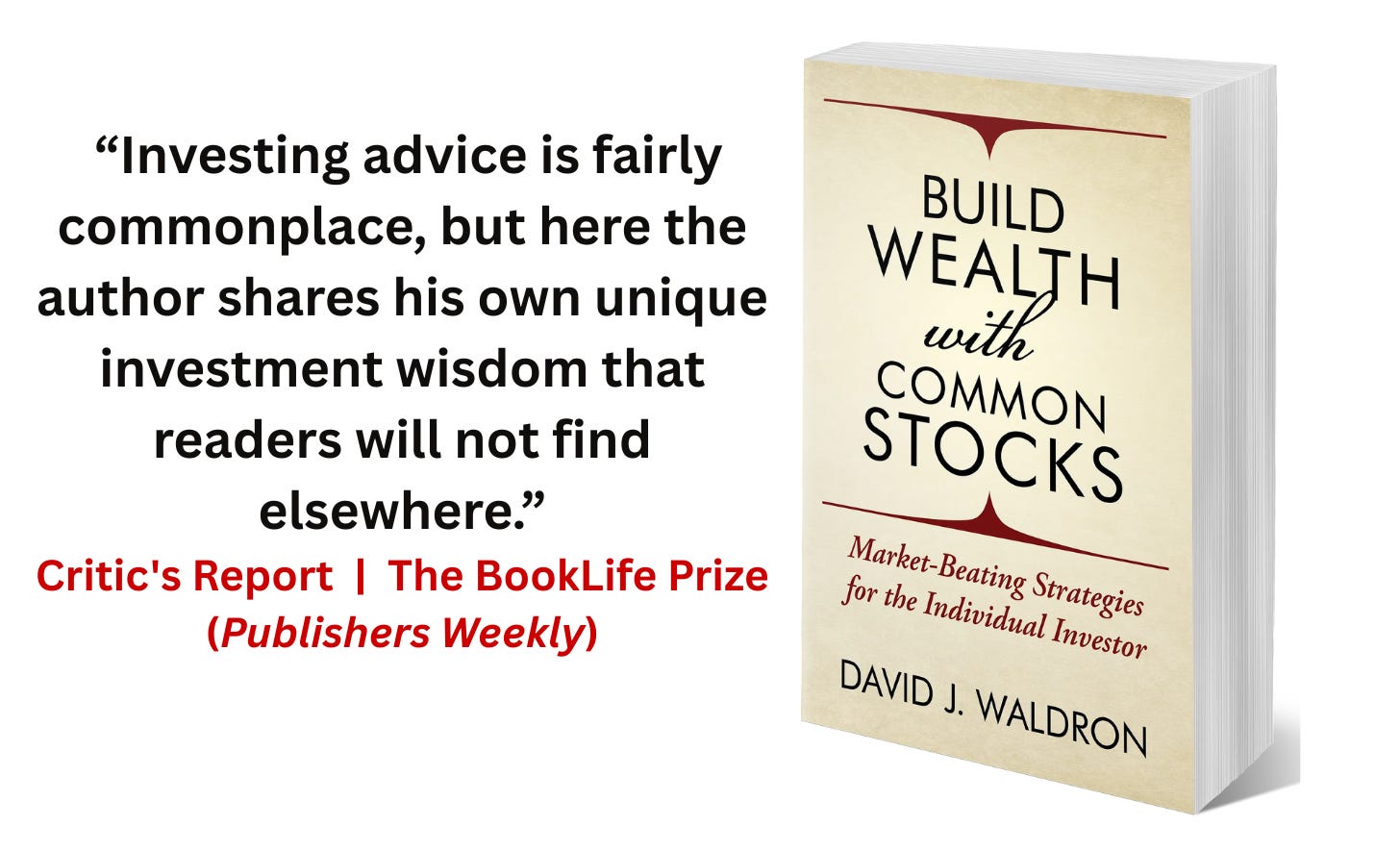Chapter Six: Own Companies Instead of Trading Stocks
Revised and updated | Build Wealth with Common Stocks: Market-Beating Strategies for the Individual Investor
Audio voiceover:
Substack’s AI-generated voiceover is now available from “By David J. Waldron.” To access it, open the chapter in the Substack app. Feel free to share your thoughts in the comments or via direct message. I will use AI to clone my voice for the book’s official audiobook release.
Learn more about audio voiceovers:
https://davidjwaldronbooks.substack.com/p/audio
Haven’t read the previous chapters? Find them here on the book’s webpage:
https://davidjwaldronbooks.substack.com/p/build-wealth-with-common-stocks
Chapter Six
Own Companies Instead of Trading Stocks
Stop trading stocks and start investing in companies.
The original idea of buying and selling stocks allowed willing investors to gain affordable ownership in publicly traded companies easily. Over time, this concept has evolved beyond simply owning common shares based on their fundamentals to include a variety of research methods, ownership types, and trading platforms.
Look for companies with strong long-term prospects, recognizing that the enduring quality of the management team — regardless of who they are at any given time — remains crucial to the investment’s success over time.
This chapter discusses the inherent benefits of investing in quality companies at current value instead of betting on equities for speculative growth.
Trade a Cigar Butt or Invest in a Bottle of Wine
The so-called cigar butts and special situations — common shares of fair companies available at low prices — are more about trading stocks and practicing arbitrage than about investing in companies, and are therefore speculative.
On the other hand, think of the endurance of a successful company like that of a fine wine, which lasts for years. The analogy reflects Warren Buffett’s realization — influenced by partner Charlie Munger — that he transitioned from being a stock trader to a company investor.
Munger’s wisdom confirms that an investor who concentrates on a select group of high-quality companies and diligently follows them has a greater chance of achieving superior returns over the long run. Conversely, trading in and out of stocks based on news, quarterly results, or market sentiment typically results in more losses than wins over time.
Get to Know the Business
Renowned stock picker Peter Lynch writes in his must-read book Beating the Street, “Behind every stock is a company. Find out what it’s doing.”1
Lynch demonstrates a strong understanding of the difference between a company’s long-term earnings and its stock price.
I am neither wise nor foolish enough to try timing the market. Instead, I look for a margin of safety in five key quantitative and qualitative areas of a business’s operational and financial performance, as further discussed in Part II: Strategies.
The successful, do-it-yourself investor focuses on profitable, free-cash-flow-rich companies that offer comfortable margins of safety. The disciplined investor owns businesses with efficient and transparent management that maximize returns for customers, employees, and shareholders.
Think of yourself as an investor who owns portions of excellent businesses instead of simply buying electronic shares of common stock through an online discount broker. The actions are similar, but the affirmation of ownership in companies feels more meaningful than just trading stocks.
After all, a bottle of good wine endures much longer than a cigar butt.
Avoid Speculative Growth: Focus on Current Value
The choice isn’t really between value and growth but between value today and value tomorrow. Growth investing represents a bet on company performance that may or may not materialize in the future, while value investing is based primarily on the analysis of a company’s current wealth.2 —HOWARD MARKS
This section begins with an ingenious quote from the renowned value investor, money manager, and author Howard Marks, from his essential book The Most Important Thing.
The wisdom of Marks encourages a skeptical view of modern measurement methods used by momentum investors and day traders, such as technical analysis or the detailed study of past price movements. The defensive investor prefers companies that are already growing and dismisses the usual promises of specific growth and price targets from analysts, financial bloggers, and senior management.
Like Howard Marks, focus on value investing through a fundamentals-driven analysis of stocks. Value today often results in growth tomorrow.
Value Leads to Growth
When performing due diligence on your portfolio, consider reviewing at least three years of historical growth in revenue, earnings per share, and dividend rates.
Look for double-digit or at least attractive compound annual growth rates (CAGR). The potential for annualized growth from total return on capital and dividends improves when buying common shares with wide margins of safety or at a price you believe is below your estimate of the stock’s intrinsic value. Part II examines these strategies in detail.
With a nod of gratitude to Howard Marks’s timeless wisdom, avoid making claims such as “XYZ shares undervalued by 27 percent.” The thoughtful, individual investor dismisses any illusion of predicting exact percentages of perceived pricing gaps, believing from research and common sense that stocks are mispriced merely in a broad sense.
If such prognostications were more often accurate — being wrong as the more common outcome — the so-called top 1 percent of wealth would move closer to perhaps 50 percent of the population due to buying and selling based on the illusion of precise price predictions. Of course, the zero-sum nature of investing eventually emerges.
Speculative growth stocks tend to fall faster and harder in a downturn than they rise in an upturn. Nonetheless, by buying value now, an investor is better positioned to benefit from growth later.
Become an Informed Investor
I learned many lessons about personal investing. Looking back, I was an uninformed investor who relied on a top-down macroeconomic approach to investing.
I was unaware of the investment style I was using at the time. Some successful investors do employ a top-down, macro-focused approach. My ineffective method involved trying to predict trends and then buying groups of stocks or funds that reflected those perceived shifts, whether in information technology, biotechnology, or by purchasing one stock from each sector of the S&P 500 and calling it a diversified, personal index. You name it — I tried it and failed; however, in hindsight, each trade seemed like a good idea at the time.
When I invested in a 401(k) at work, the usual options were limited to a small selection of mutual funds with higher-than-average advisory fees. However, I was lucky that those funds included Charles Royce’s Royce Total Return (RYTRX), William H. Browne’s Tweedy, Browne Global Value (TBGVX), and the late Martin Whitman’s Third Avenue Value (TVFVX). I read each quarterly and annual report from these experienced, professional value investors, learning about bottom-up investing, the positive influence of Benjamin Graham, and how owning companies through disciplined investment was more noble and profitable than trading stocks on speculation.
Despite the excellent capital gains and dividends earned — as well as the acquired wisdom — I sold each fund after realizing I was leaving too much money on the table in the form of investment advisory fees exceeding 1 percent per year. At the same time, Warren Buffett, Peter Lynch, John Bogle, and Howard Marks were each capturing my attention. I learned it was possible to invest in publicly traded companies, combining Buffett’s wisdom, Lynch’s stock-picking discipline, Bogle’s emphasis on lower costs, and Marks’ understanding of risk. Still, I am forever grateful to Chuck, Bill, and Marty for teaching me the art and science of value investing from afar. From their stories, I also learned the importance of writing an investment thesis with touches of wit, humor, and sarcasm. After all, it is just money.
In the short run, the crowd is almost always wrong. Trend investing is similar to investing in junk bonds, the Slinky, or Bitcoin: a few make a lot, although many lose big. “I’m gonna get in early and rake,” says the uninformed investor.
The better option is to beat the market by becoming a knowledgeable investor.
Ignore the Wall Street Darlings
The knowledgeable investor on Main Street understands that a stock admired by Wall Street has little influence when it comes to measuring the company’s potential or the actual value of its stock price.
I have worked for companies branded as Wall Street darlings and wondered if the analysts knew what I knew. And Wall Street ended up wrong each time. As high-flying start-ups, growth stocks sometimes are calculated bets worth taking; however, as long-term quality investments, each is more a roll of the dice or speculative at best. An exception to the rule is an enterprise whose name mirrors a particular fruit with a solid core and a reputation for keeping the doctor away.
Consider those who bought $1,000 worth of Apple stock for a split-adjusted ten cents a share in 1980 but sold it due to a perceived significant issue. The rare shareholder who held on through the return of Steve Jobs, the launch of the iMac, iPod, iPhone, and iPad, along with the steady leadership of Jobs’ chosen successor, Tim Cook, was rewarded generously, earning several million dollars in capital gains when accounting for reinvested dividends and inflation as of the calculation date. Apple serves as a clear example of how a buy-and-hold strategy can pay off for the patient investor.
Chasing Growth from A to Z
Avoid trying to predict exact future margins and cash flows, and instead focus on identifying excellent companies trading at fair prices through thorough research and analysis of their current value.
Remember, in the stock-picking process of the thoughtful, disciplined, and patient investor, the rearview and side view mirrors are clear, while the windshield remains foggy. Invest with proper diligence by examining the rear and side views and using common sense and instinct, rather than focusing through the windshield or trying to see into a crystal ball. Ask yourself: Would you invest in this company if it were owned privately by a friend asking you to become a silent partner?
Analysts and executives provide projections and guidance. Then, the crowd tries to estimate — or accept at face value — future earnings, stock price targets, margins, and cash flow. But how reliable is the forecasted data?
Based on personal experience and observations, such prognostications are worthless. Instead, deduce the likelihood of a business continuing to generate or improve top-line revenue, profit margins, and free cash flow through solid research. Buy small stakes in excellent companies when macro or microeconomic events create windows of value pricing opportunities. Avoid predicting the exact future direction of stock prices. As with other major purchases made during a lifetime, caveat emptor applies to common stock investing as well.
Hindsight being the proverbial 20/20, I overlooked the early successes of the online retail giant Amazon (NASDAQ: AMZN) because it didn’t meet most of my investing criteria. It’s plausible to think that Amazon investors took risks on other speculative growth stocks that eventually failed. Unless you’re in the right place at the right time — like an Amazon employee or vendor — it often takes holding several underperforming speculative growth stocks to find the one that transformed from an online bookseller into a company selling products representing every letter of the alphabet.
When reading the typical buy-and-sell-on-the-news frenzy in the financial media, hold a glass apple paperweight up to the comment so it looks like it’s shining through a Magic 8-Ball. You might find it makes the comments seem much more appropriate.
Value and growth together are known as “growth at a reasonable price” or GARP, serving as a reminder that this once-popular investing approach was out of favor during the recent growth-driven bull market. The “at a reasonable price” aspect of the GARP formula had faded, even though the growth element remained, providing the needed elixir.
A sensible point is that careful and disciplined investing requires a focus on valuation. Investors purchase securities expecting prices to rise by the end of the day, week, year, or decade. So, why do many fail at the valuation aspect?
An investor who purchases the stock of a non-dividend-paying growth company for the earnings risks disappointment. The opportunity is in the top-line revenue growth of Seattle, Washington-based Amazon. It also includes high-profile, non-dividend-paying Silicon Valley stocks such as content streaming pioneer Netflix (NASDAQ: NFLX) and Alphabet (NASDAQ: GOOG, GOOGL), parent of YouTube and Google.
The preferred approach is to find an entry point by evaluating how macro- or micro-events impact valuation, rather than trying to predict exact future outcomes. Avoid setting price targets, as speculation often disappoints more than it excites. Say no to schemes and focus on low-cost, lower-risk investments in high-quality, dividend-paying stocks bought at realistic prices. Then, hold the shares as long as the business remains strong, including potentially forever. The key lesson is that successful, self-reliant investors perform research and analysis of companies they wish to own. Stock trading becomes simply a means to support the primary goal of ownership.
The best advice given to investors who don’t have the DNA-inspired talent of the rare successful fast money trader — myself included — is to stop betting on speculative stocks and start investing in quality businesses.
CHAPTER SIX SUMMARY
On Owning Companies Versus Trading Stocks
Contribute to society and yourself or your family by owning common shares of businesses that maintain quality and compliance in an unpredictable world.
Defensive investors favor companies that are already growing, ignoring any growth promises from analysts, bloggers, or management.
In both the short term and the long term, the crowd is almost always mistaken. Outperform the market by becoming a well-informed investor.
By investing in value now, the careful, disciplined, and patient common stock investor profits from growth in the future.
Stop betting on stocks and start investing in companies. This original idea of trading stocks allowed willing participants to buy affordable partial shares in publicly traded companies. The approach remains the ideal model.
This updated chapter is copyrighted 2021 and 2025 by David J. Waldron. All rights are reserved worldwide.
Next in Build Wealth with Common Stocks | Chapter Seven: Buy Fear and Sell Greed
Universal links allow you to preview or purchase David’s published print or ebooks — each available globally at your preferred online bookstores — with one or two clicks, brought to you by our trusted partner, BookFunnel.
Share the “By David J. Waldron” author website with your network to earn credits for a premium subscription that provides full-text and audio access to all of David’s manuscripts and updated chapters of his published self-help books.
Peter Lynch and John Rothchild, Beating the Street (New York: Simon & Schuster, 1993, 1994), 305.
Howard Marks, The Most Important Thing (New York: Columbia University Press, 2011), 19–20. The original quote was published in Marks’s memo to Oaktree Capital Management, L.P. clients: “The Happy Medium,” July 21, 2004.









